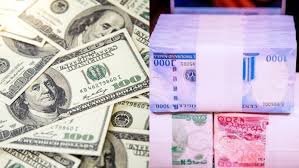The naira recorded a slight gain on the Nigerian Foreign Exchange Market on Friday, closing at ₦1,531.57 per dollar. This marked a 0.23 per cent appreciation compared to the previous week, when the exchange rate stood at the same ₦1,531.57 per dollar level but was weaker on closing.
On a month-on-month basis, the naira also appreciated by 0.13 per cent when compared to ₦1,533.55 per dollar at the end of July. This showed a reversal from the negative trend recorded in July 2025. In July, the naira had ended the month at ₦1,533.55 per dollar, representing a 0.25 per cent decline from the ₦1,529.71 per dollar it closed with in June.
Meanwhile, Nigeria’s external reserves have continued to grow steadily. From $41.00 billion at the beginning of August, the reserves closed at $41.27 billion as of Friday. The consistent rise in reserves has been viewed as a positive sign for the country’s financial stability and a source of support for the currency.
Financial analysts at Cowry Assets Management, in their weekly market review, noted that the naira’s stronger performance in the official market was linked to improved market liquidity and sustained dollar inflows. They said the parallel market also experienced a marginal improvement, with the naira gaining 0.37 per cent on a week-on-week basis to settle at an average of ₦1,538.33 per dollar.
According to them, this slight recovery in the informal market reflects renewed confidence among traders as well as reduced speculative activities that had previously weakened the local currency.
The experts, however, cautioned that while the naira is likely to trade within a stable range in the new week, demand pressures and the stronger U.S. dollar could restrict further gains. They highlighted the role of Central Bank of Nigeria interventions, particularly dollar sales to the market, as a critical factor in keeping volatility under control.
AIICO Capital, in its own review of foreign exchange trends, explained that trading opened last week with strong dollar demand, which pushed rates towards ₦1,540 per dollar. The Central Bank responded by selling about $70 million in the market across several sessions, which helped restore calm and reduce pressure.
By midweek, improved supply and continued interventions kept the market stable within the ₦1,525 to ₦1,538 per dollar range. Towards the end of the week, the naira strengthened slightly as supply increased and demand moderated, closing at ₦1,531.57 per dollar. AIICO Capital described this as a firming of the currency by 22.6 basis points compared to the previous week.
Looking ahead, both Cowry Assets and AIICO Capital expect the naira to remain broadly stable in the coming days, supported by steady foreign exchange inflows and CBN actions.
This aligns with earlier projections by PwC in its 2025 Economic Outlook, which predicted that the naira would remain stable throughout the year due to reforms by the Central Bank and improved portfolio inflows into the Nigerian economy.
Despite the positive trend, analysts continue to caution that Nigeria’s foreign exchange market remains vulnerable to shocks such as a sudden surge in demand for dollars, tightening global liquidity, or a stronger U.S. currency. They stressed that the growth in external reserves must be sustained to provide a solid buffer for the naira.
Market watchers are now closely observing whether the gains recorded in August will be maintained into September, particularly as businesses prepare for end-of-quarter financial obligations, which often trigger fresh demand for foreign exchange.
For many Nigerians, the exchange rate remains an important indicator of economic stability, as it directly affects prices of imported goods, fuel, raw materials, and even school fees abroad. Any improvement in the value of the naira is therefore seen as a relief for households and businesses struggling with rising costs.
The Central Bank of Nigeria has repeatedly assured that it will continue to intervene in the forex market to ensure stability, while also implementing long-term reforms aimed at boosting dollar supply through non-oil exports, remittances, and investment inflows.
As August closes, the naira’s slight appreciation and the rising external reserves offer cautious optimism. However, economic experts insist that only sustained reforms, increased exports, and stronger investor confidence can secure a lasting recovery for Nigeria’s currency.
